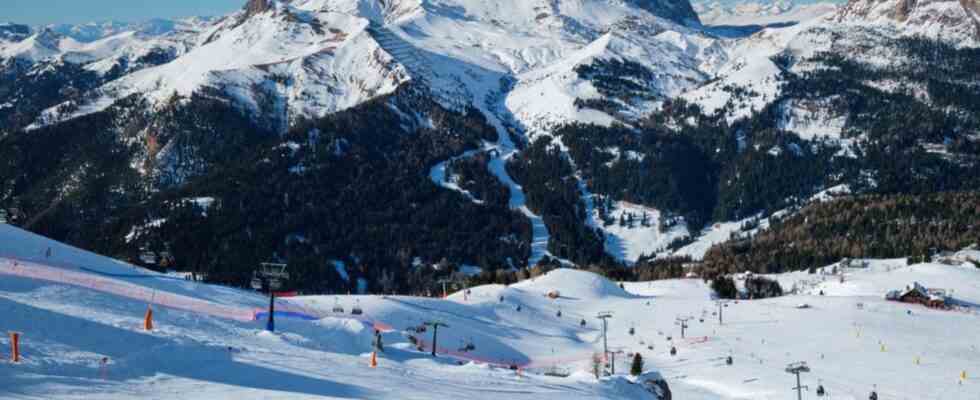Dolomites
This is how the UNESCO World Heritage attracts ski fans
Hit the slopes with a clear conscience: The Dolomites have turned the green screw.
© Dmitry Rukhlenko/Shutterstock.com
How green can snow be? Winter sports fans and sun worshipers will find out in the Dolomites. Buon divertimento in UNESCO World Heritage!
“Are they rocks or clouds? Are they real or just a dream?” The Italian writer Dino Buzzati (1906-1972) was already enchanted by the beauty of the Dolomites in his work “Le montagne di vetro” (in English: “The glass mountains”, 1956). A good 50 years later, UNESCO joined in and declared parts of the mountain range to be World Heritage sites. The “sublime, monumental and colorful landscapes (…) have always fascinated a large number of travelers,” the committee explains. Winter sports fans in particular are regularly drawn to the Italian Dolomite provinces of Trentino, South Tyrol and Belluno. The sun shines there on average eight out of ten days of skiing.
Olympia 2026 is coming to Cortina d’Ampezzo
Among the 16 ski areas of the Dolomiti Superski network there are also some that not only provide fun in the snow and relaxation, but also have a lot of excitement and surprises up their sleeve: The famous downhill run Saslong in Gröden has so far produced the most surprise winners in the history of the Ski World Cup. Most recently, the American Bryce Bennett (29) was at the top of the podium. But many skiers also mark the events around the Alta Badia and Cortina d’Ampezzo areas in red on their calendars. The latter, along with Milan, is even the venue for the upcoming 2026 Winter Olympics.
After the issue of sustainability was a major point of criticism at the Beijing Games, Italy wants to present itself greener before the start of the 2026 Olympics – starting with electricity. The 450 modern and quiet lifts at the Dolomiti Superski destination do not emit any exhaust fumes and are operated with hydroelectric power. Improvements have also been made to the snowmaking system: the water required is collected during the summer months. This should not stress springs and streams for snow production in winter. Additives are completely dispensed with when “whitening” the slopes.
Alpenglow, panoramic views and a legend king
In the twelve valleys with 1,200 kilometers of pistes, you are spoiled for choice between blue (40 percent, easy), red (46 percent, medium) and black (14 percent, difficult) runs. The Val di Fassa/Carezza ski area is suitable for adrenaline junkies as well as romantics. It lies between Latemar and the Rosengarten, where the legend king Laurin is at home.
In the Snowpark Carezza, winter sports fans can let off steam as they please. If you like speed, you can try the Tschein descent, then strengthen yourself in an alpine hut or enjoy a special sight in the evening hours with a Bombardino (egg-based cocktail): the Alpenglühen. The spectacle, also known as “Enrosadira”, bathes the mountain peaks in reddish-violet light in the morning and evening hours. Anyone who likes panoramic views will love Carezza.
Big tour on the Sellaronda
The Sellaronda is a round thing in the truest sense of the word. The tour extends over the four Dolomite passes around the Sella massif. You drive through the Ladin valleys of Gröden, Alta Badia, Arabba and the Fassa Valley and should be in good physical condition for the total of 40 kilometers (27 kilometers of slopes). If that’s not enough for you, the best thing to do is to go on the mountain infantry tour. It runs under the walls of the famous peaks of Civetta, Monte Pelmo, Tofana, Lagazuoi, Conturines, Settsass, Sassongher, Sella and Marmolada.
The Gitschberg Jochtal is ideal for a winter family holiday. There, in one of the many ski schools, the little ones learn how to dash down the mountain with two skis under their feet. Overnight stays and excursions are available in Meransen or Terenten, also known as the sunny village of the Puster Valley, on the sun-kissed plateau above the municipality of Mühlbach. A trip to Brixen, the oldest town in Tyrol, is also worthwhile. The highlight is the cathedral with its baroque towers – the local mountain Plose is enthroned in the background. It invites you to go skiing and hiking in equal measure.
This is what the Dolomites taste like
Of course, between the sun and the snow, your stomach will also let you know, after all, the Dolomites not only want to be discovered, but also tasted. There should be something for every foodie: from the rustic parlor on the summit down to the chic valley restaurant. Spinach tartlets meet Schlutzkrapfen and Ampezzo casunziei. And why not close the stomach with some Tosela cheese? Strengthened, it then goes back to the sunny slopes of the UNESCO World Heritage Dolomites: Buon divertimento!

